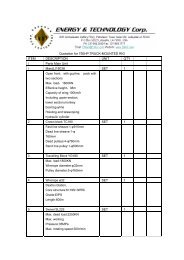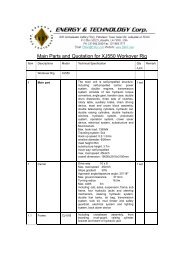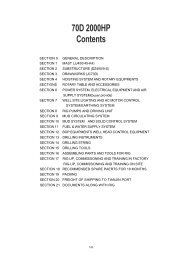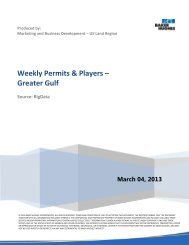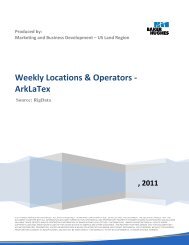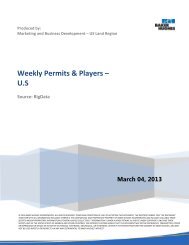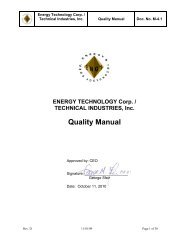Technical Industries, Inc. W-9 Form
Technical Industries, Inc. W-9 Form
Technical Industries, Inc. W-9 Form
You also want an ePaper? Increase the reach of your titles
YUMPU automatically turns print PDFs into web optimized ePapers that Google loves.
<strong>Form</strong> W-9 Request for Taxpayer(Rev. January 2003)Identification Number and CertificationDepartment of the TreasuryInternal Revenue ServicePrint or typeSee Specific Instructions on page 2.NameBusiness name, if different from aboveCheck appropriate box:Address (number, street, and apt. or suite no.)City, state, and ZIP codeList account number(s) here (optional)Give form to therequester. Do notsend to the IRS.Individual/Exempt from backupSole proprietor Corporation Partnership Other withholdingRequester’s name and address (optional)Part ITaxpayer Identification Number (TIN)Enter your TIN in the appropriate box. For individuals, this is your social security number (SSN).However, for a resident alien, sole proprietor, or disregarded entity, see the Part I instructions onpage 3. For other entities, it is your employer identification number (EIN). If you do not have a number,see How to get a TIN on page 3.Social security number– –Note: If the account is in more than one name, see the chart on page 4 for guidelines on whose number Employer identification numberto enter. –Part IICertificationUnder penalties of perjury, I certify that:1. The number shown on this form is my correct taxpayer identification number (or I am waiting for a number to be issued to me), and2. I am not subject to backup withholding because: (a) I am exempt from backup withholding, or (b) I have not been notified by the InternalRevenue Service (IRS) that I am subject to backup withholding as a result of a failure to report all interest or dividends, or (c) the IRS hasnotified me that I am no longer subject to backup withholding, and3. I am a U.S. person (including a U.S. resident alien).Certification instructions. You must cross out item 2 above if you have been notified by the IRS that you are currently subject to backupwithholding because you have failed to report all interest and dividends on your tax return. For real estate transactions, item 2 does not apply.For mortgage interest paid, acquisition or abandonment of secured property, cancellation of debt, contributions to an individual retirementarrangement (IRA), and generally, payments other than interest and dividends, you are not required to sign the Certification, but you mustprovide your correct TIN. (See the instructions on page 4.)SignHereSignature ofU.S. person Purpose of <strong>Form</strong>A person who is required to file an information return withthe IRS, must obtain your correct taxpayer identificationnumber (TIN) to report, for example, income paid to you, realestate transactions, mortgage interest you paid, acquisitionor abandonment of secured property, cancellation of debt, orcontributions you made to an IRA.U.S. person. Use <strong>Form</strong> W-9 only if you are a U.S. person(including a resident alien), to provide your correct TIN to theperson requesting it (the requester) and, when applicable, to:1. Certify that the TIN you are giving is correct (or you arewaiting for a number to be issued),2. Certify that you are not subject to backup withholding,or3. Claim exemption from backup withholding if you are aU.S. exempt payee.Note: If a requester gives you a form other than <strong>Form</strong> W-9to request your TIN, you must use the requester’s form if it issubstantially similar to this <strong>Form</strong> W-9.Foreign person. If you are a foreign person, use theappropriate <strong>Form</strong> W-8 (see Pub. 515, Withholding of Tax onNonresident Aliens and Foreign Entities).Date Nonresident alien who becomes a resident alien.Generally, only a nonresident alien individual may use theterms of a tax treaty to reduce or eliminate U.S. tax oncertain types of income. However, most tax treaties contain aprovision known as a “saving clause.” Exceptions specifiedin the saving clause may permit an exemption from tax tocontinue for certain types of income even after the recipienthas otherwise become a U.S. resident alien for tax purposes.If you are a U.S. resident alien who is relying on anexception contained in the saving clause of a tax treaty toclaim an exemption from U.S. tax on certain types of income,you must attach a statement that specifies the following fiveitems:1. The treaty country. Generally, this must be the sametreaty under which you claimed exemption from tax as anonresident alien.2. The treaty article addressing the income.3. The article number (or location) in the tax treaty thatcontains the saving clause and its exceptions.4. The type and amount of income that qualifies for theexemption from tax.5. Sufficient facts to justify the exemption from tax underthe terms of the treaty article.orCat. No. 10231X<strong>Form</strong> W-9 (Rev. 1-2003)
<strong>Form</strong> W-9 (Rev. 1-2003) Page 2Example. Article 20 of the U.S.-China income tax treatyallows an exemption from tax for scholarship incomereceived by a Chinese student temporarily present in theUnited States. Under U.S. law, this student will become aresident alien for tax purposes if his or her stay in the UnitedStates exceeds 5 calendar years. However, paragraph 2 ofthe first Protocol to the U.S.-China treaty (dated April 30,1984) allows the provisions of Article 20 to continue to applyeven after the Chinese student becomes a resident alien ofthe United States. A Chinese student who qualifies for thisexception (under paragraph 2 of the first protocol) and isrelying on this exception to claim an exemption from tax onhis or her scholarship or fellowship income would attach to<strong>Form</strong> W-9 a statement that includes the informationdescribed above to support that exemption.If you are a nonresident alien or a foreign entity notsubject to backup withholding, give the requester theappropriate completed <strong>Form</strong> W-8.What is backup withholding? Persons making certainpayments to you must under certain conditions withhold andpay to the IRS 30% of such payments (29% after December31, 2003; 28% after December 31, 2005). This is called“backup withholding.” Payments that may be subject tobackup withholding include interest, dividends, broker andbarter exchange transactions, rents, royalties, nonemployeepay, and certain payments from fishing boat operators. Realestate transactions are not subject to backup withholding.You will not be subject to backup withholding on paymentsyou receive if you give the requester your correct TIN, makethe proper certifications, and report all your taxable interestand dividends on your tax return.Payments you receive will be subject to backupwithholding if:1. You do not furnish your TIN to the requester, or2. You do not certify your TIN when required (see the PartII instructions on page 4 for details), or3. The IRS tells the requester that you furnished anincorrect TIN, or4. The IRS tells you that you are subject to backupwithholding because you did not report all your interest anddividends on your tax return (for reportable interest anddividends only), or5. You do not certify to the requester that you are notsubject to backup withholding under 4 above (for reportableinterest and dividend accounts opened after 1983 only).Certain payees and payments are exempt from backupwithholding. See the instructions below and the separateInstructions for the Requester of <strong>Form</strong> W-9.PenaltiesFailure to furnish TIN. If you fail to furnish your correct TINto a requester, you are subject to a penalty of $50 for eachsuch failure unless your failure is due to reasonable causeand not to willful neglect.Civil penalty for false information with respect towithholding. If you make a false statement with noreasonable basis that results in no backup withholding, youare subject to a $500 penalty.Criminal penalty for falsifying information. Willfullyfalsifying certifications or affirmations may subject you tocriminal penalties including fines and/or imprisonment.Misuse of TINs. If the requester discloses or uses TINs inviolation of Federal law, the requester may be subject to civiland criminal penalties.Specific InstructionsNameIf you are an individual, you must generally enter the nameshown on your social security card. However, if you havechanged your last name, for instance, due to marriagewithout informing the Social Security Administration of thename change, enter your first name, the last name shown onyour social security card, and your new last name.If the account is in joint names, list first, and then circle,the name of the person or entity whose number you enteredin Part I of the form.Sole proprietor. Enter your individual name as shown onyour social security card on the “Name” line. You may enteryour business, trade, or “doing business as (DBA)” name onthe “Business name” line.Limited liability company (LLC). If you are a single-memberLLC (including a foreign LLC with a domestic owner) that isdisregarded as an entity separate from its owner underTreasury regulations section 301.7701-3, enter the owner’sname on the “Name” line. Enter the LLC’s name on the“Business name” line.Other entities. Enter your business name as shown onrequired Federal tax documents on the “Name” line. Thisname should match the name shown on the charter or otherlegal document creating the entity. You may enter anybusiness, trade, or DBA name on the “Business name” line.Note: You are requested to check the appropriate box foryour status (individual/sole proprietor, corporation, etc. ).Exempt From Backup WithholdingIf you are exempt, enter your name as described above andcheck the appropriate box for your status, then check the“Exempt from backup withholding” box in the line followingthe business name, sign and date the form.Generally, individuals (including sole proprietors) are notexempt from backup withholding. Corporations are exemptfrom backup withholding for certain payments, such asinterest and dividends.Note: If you are exempt from backup withholding, you shouldstill complete this form to avoid possible erroneous backupwithholding.Exempt payees. Backup withholding is not required on anypayments made to the following payees:1. An organization exempt from tax under section 501(a),any IRA, or a custodial account under section 403(b)(7) if theaccount satisfies the requirements of section 401(f)(2);2. The United States or any of its agencies orinstrumentalities;3. A state, the District of Columbia, a possession of theUnited States, or any of their political subdivisions orinstrumentalities;4. A foreign government or any of its political subdivisions,agencies, or instrumentalities; or5. An international organization or any of its agencies orinstrumentalities.Other payees that may be exempt from backupwithholding include:6. A corporation;7. A foreign central bank of issue;8. A dealer in securities or commodities required to registerin the United States, the District of Columbia, or apossession of the United States;
<strong>Form</strong> W-9 (Rev. 1-2003) Page 39. A futures commission merchant registered with theCommodity Futures Trading Commission;10. A real estate investment trust;11. An entity registered at all times during the tax yearunder the Investment Company Act of 1940;12. A common trust fund operated by a bank undersection 584(a);13. A financial institution;14. A middleman known in the investment community as anominee or custodian; or15. A trust exempt from tax under section 664 ordescribed in section 4947.The chart below shows types of payments that may beexempt from backup withholding. The chart applies to theexempt recipients listed above, 1 through 15.If the payment is for . . .Interest and dividend paymentsBroker transactionsBarter exchange transactionsand patronage dividendsPayments over $600 requiredto be reported and directsales over $5,000 1THEN the payment is exemptfor . . .All exempt recipients exceptfor 9Exempt recipients 1 through 13.Also, a person registered underthe Investment Advisers Act of1940 who regularly acts as abrokerExempt recipients 1 through 5Generally, exempt recipients1 through 7 21See <strong>Form</strong> 1099-MISC, Miscellaneous <strong>Inc</strong>ome, and its instructions.2However, the following payments made to a corporation (including grossproceeds paid to an attorney under section 6045(f), even if the attorney is acorporation) and reportable on <strong>Form</strong> 1099-MISC are not exempt from backupwithholding: medical and health care payments, attorneys’ fees; and paymentsfor services paid by a Federal executive agency.Part I. Taxpayer IdentificationNumber (TIN)Enter your TIN in the appropriate box. If you are a residentalien and you do not have and are not eligible to get anSSN, your TIN is your IRS individual taxpayer identificationnumber (ITIN). Enter it in the social security number box. Ifyou do not have an ITIN, see How to get a TIN below.If you are a sole proprietor and you have an EIN, you mayenter either your SSN or EIN. However, the IRS prefers thatyou use your SSN.If you are a single-owner LLC that is disregarded as anentity separate from its owner (see Limited liabilitycompany (LLC) on page 2), enter your SSN (or EIN, if youhave one). If the LLC is a corporation, partnership, etc., enterthe entity’s EIN.Note: See the chart on page 4 for further clarification ofname and TIN combinations.How to get a TIN. If you do not have a TIN, apply for oneimmediately. To apply for an SSN, get <strong>Form</strong> SS-5,Application for a Social Security Card, from your local SocialSecurity Administration office or get this form on-line atwww.ssa.gov/online/ss5.html. You may also get this formby calling 1-800-772-1213. Use <strong>Form</strong> W-7, Application forIRS Individual Taxpayer Identification Number, to apply for anITIN, or <strong>Form</strong> SS-4, Application for Employer IdentificationNumber, to apply for an EIN. You can get <strong>Form</strong>s W-7 andSS-4 from the IRS by calling 1-800-TAX-FORM(1-800-829-3676) or from the IRS Web Site at www.irs.gov.If you are asked to complete <strong>Form</strong> W-9 but do not have aTIN, write “Applied For” in the space for the TIN, sign anddate the form, and give it to the requester. For interest anddividend payments, and certain payments made with respectto readily tradable instruments, generally you will have 60days to get a TIN and give it to the requester before you aresubject to backup withholding on payments. The 60-day ruledoes not apply to other types of payments. You will besubject to backup withholding on all such payments until youprovide your TIN to the requester.Note: Writing “Applied For” means that you have alreadyapplied for a TIN or that you intend to apply for one soon.Caution: A disregarded domestic entity that has a foreignowner must use the appropriate <strong>Form</strong> W-8.



